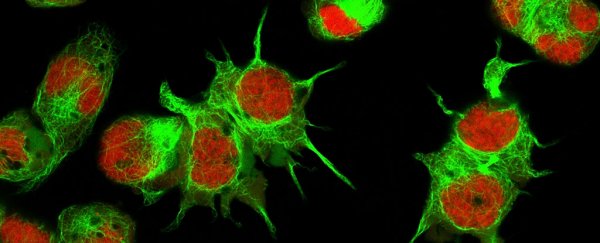Is cancer a result of extrinsic risk factors such as environmental exposures and personal behaviour, or is it just a case of bad luck?
According to new research by Stony Brook University, extrinsic factors – for example, smoking cigarettes, or living in a heavily polluted area – appear to weigh heavily on the development of most cancers, which contradicts a controversial study from earlier in the year that concluded many cancers result primarily from "bad luck".
The earlier paper, published in Science in January and written by researchers at Johns Hopkins University, suggested that as much as two-thirds of adult cancer incidence across tissues was primarily the result of bad luck. They cited random mutations occurring in genes that can drive cancer growth as being the main culprit.
"These results suggest that only a third of the variation in cancer risk among tissues is attributable to environmental factors or inherited predispositions," the team wrote. "The majority is due to 'bad luck', that is, random mutations arising during DNA replication in normal, noncancerous stem cells."
"This study shows that you can add to your risk of getting cancers by smoking or other poor lifestyle factors," explained one of the researchers, oncologist Bert Vogelstein. "However, many forms of cancer are due largely to the bad luck of acquiring a mutation in a cancer driver gene regardless of lifestyle and heredity factors. The best way to eradicate these cancers will be through early detection, when they are still curable by surgery."
The conclusion evoked some criticism from the scientific community, and now new findings from the Stony Brook researchers assert that the vast majority of cancers – approximately 70 to 90 percent – stem from environmental exposure and individual behaviours.
"Many scientists argued against the 'bad luck' or 'random mutation' theory of cancer but provided no alternative analysis to quantify the contribution of external risk factors," said Song Wu, lead author of the new study. "Our paper provides an alternative analysis by applying four distinct analytic approaches."
Firstly, the researchers examined epidemiological data that showed the lifetime risk of cancer was tied to external factors – for example, research related to immigrants which shows that when people move from countries with lower cancer incidence to countries with higher rates, they acquire the higher risk of their new home.
Second, they analysed recent studies on mutational signatures in cancer and found that the majority of cancers – including colorectal, lung, bladder, and thyroid cancer – feature large proportions of mutations likely caused by extrinsic factors.
Third, using data from the SEER program (Surveillance, Epidemiology and End Results), they showed how many cancers had increased in incidence and mortality – suggesting the impact of external factors.
Finally, they used computational modelling to analyse the contribution of intrinsic processes in the development of cancer, and found that intrinsic processes by themselves are not sufficient to account for observed cancer risks.
The researchers believe their approach, using multiple methods of data- and model-driven analysis, could provide a new framework for quantifying lifetime cancer risks stemming from both intrinsic and extrinsic factors.
"Collectively, we conclude that cancer risk is heavily influenced by extrinsic factors," they write in Nature. "These results are important for strategising cancer prevention, research and public health."
But the debate isn't over yet. According to an editorial in Nature by Heidi Ledford, the authors of the "bad luck" study say that their maligned research – also criticised by another recent paper – has been taken out of context:
Tomasetti counters that he never intended to explain why cancers develop. His analysis, he says, was based on normal stem-cell division in healthy tissue and was meant to explain only why some cancers are more prevalent than others. He also argues that the models created by [Stony Brook University] make too many assumptions and fail to incorporate some features of tumour growth.
This is science at work right here, with conflicting theories making their case! Will any researchers come to the defence of the "bad luck" argument?
